Orthodontics
When consumers think about orthodontics, braces are the first thing to come to mind. However, orthodontics is more than just braces. Orthodontists are concerned with the position of the teeth, what has caused them to arrive at their current position, and what future movement may be needed so that a patient’s bite is fully functional.
Clear Orthodontics Aligners
Clear orthodontic aligners can straighten a dental patient’s teeth without the wires and brackets of traditional braces. The aligners consist of a sequence of clear, removable trays that fit over the teeth to straighten them. Each tray must be worn by the patient for a specified amount of time—usually around 20 hours a day for two weeks–before the patient can progress to the next tray. In most situations, the aligners can straighten teeth in anywhere from six to 18 months.
Clear orthodontic aligners are suitable for patients with mild or moderate crowding, or minor spacing issues. They may not be appropriate for patients with severe crowding or spacing. While the aligners can correct a mild malocclusion, patients with severe underbites, overbites or crossbites may require more advanced orthodontic treatment.
Unlike traditional braces, the trays can be removed for brushing, flossing, and eating. Because the trays are clear, patients can undergo this type of orthodontic treatment without the usual discomfort associated with regular braces.
Although treatment prices for aligners are normally set by the individual dentist or orthodontist, they can be more expensive than braces. If a patient fails to wear the trays properly, or loses them, additional costs may be incurred if new trays or impressions of a patient’s teeth are needed.


